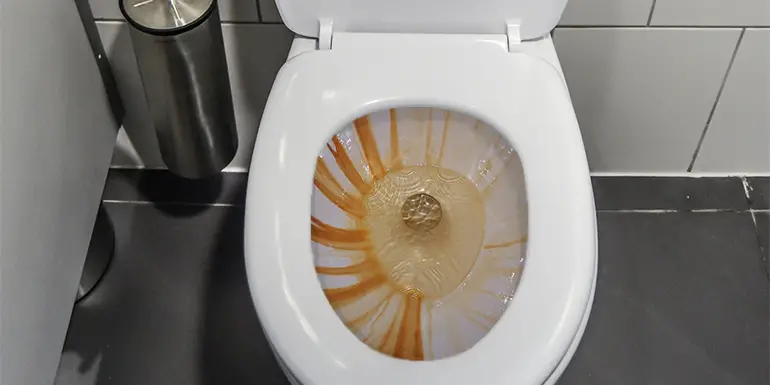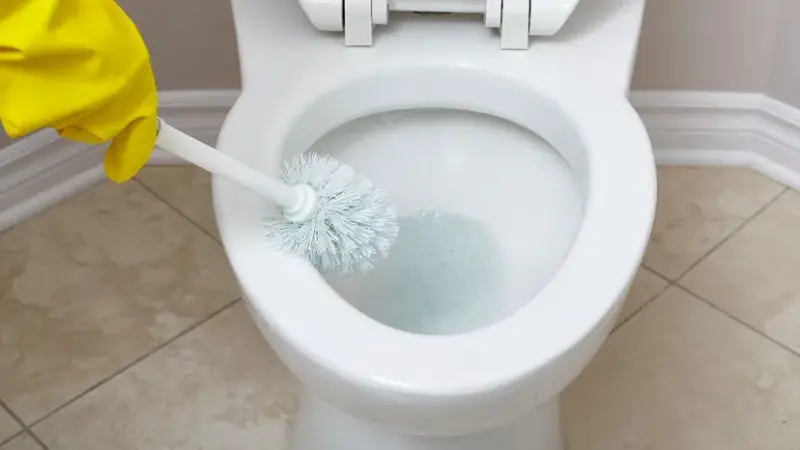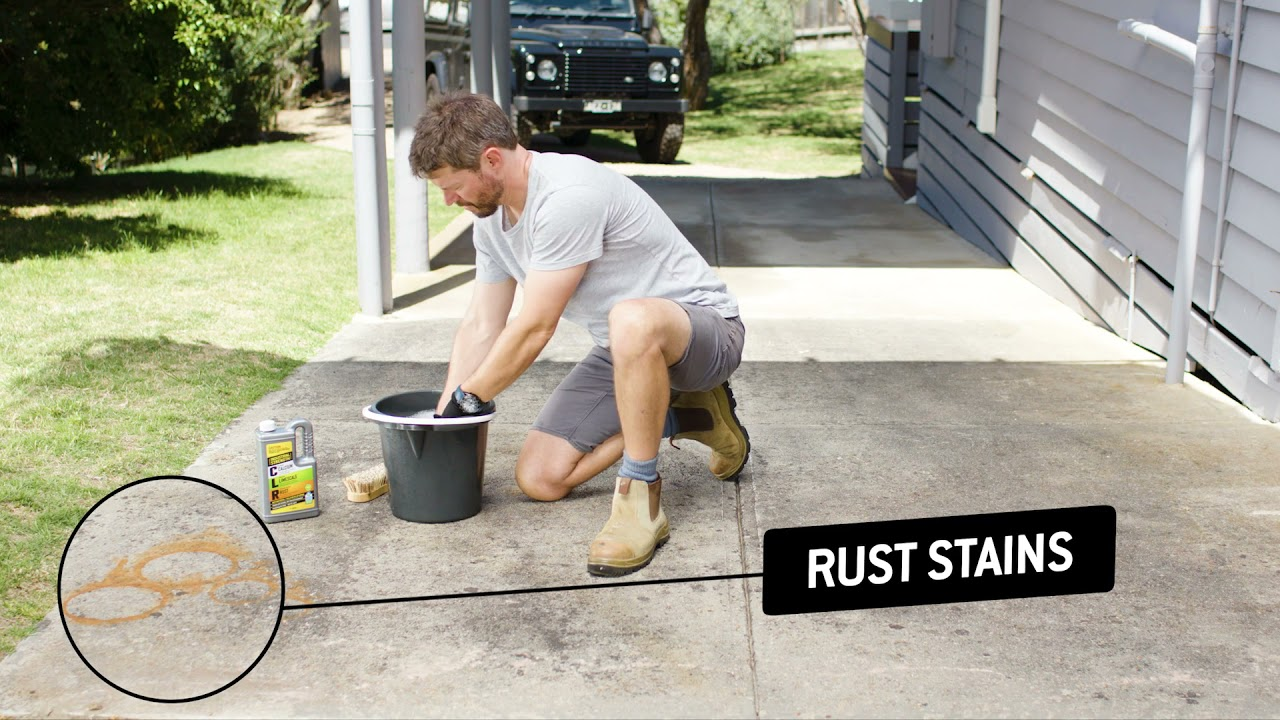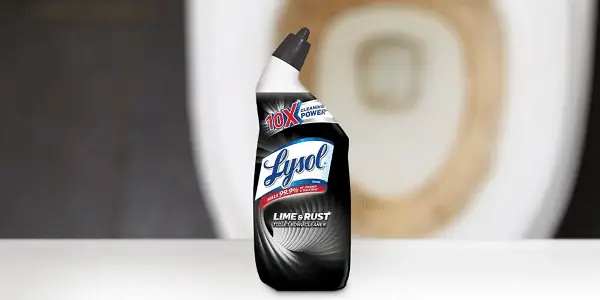Rust in toilet bowls is a common issue that plagues many households. Not only is it unsightly, but it can also indicate a larger problem with your plumbing system. Rust buildup can also cause discoloration of your toilet water, making it difficult to clean and leaving your bathroom looking dingy and unclean. In this blog post, we will explore the reasons behind rust formation in toilet bowls, the potential health hazards associated with it, and most importantly, the various methods you can use to get rid of it.
So, why is rust appearing in your toilet bowl in the first place? There are several possible causes, including iron in the water supply, corroded pipes, and outdated fixtures. However, regardless of the source of the rust, it’s important to address the issue as soon as possible to avoid any potential health hazards and maintain the overall appearance of your bathroom. In this post, we will look at various cleaning methods that can help you get rid of rust in your toilet bowl, from DIY home remedies to store-bought products. Whether you’re a homeowner or a renter, it’s important to have a clean and safe bathroom, and this post will provide you with the information you need to make that happen.
Rust In Toilet Bowl: Brief Overview
rust in toilet bowls is a total bummer! But don’t worry, there are a ton of great products, methods, and materials that can help you tackle it.
First of all, let’s talk about the cleaning products. There are a ton of options out there, and I’ve had great luck with a lot of them. One of my favorites is a product called “Iron Out.” It’s super easy to use, you just pour it into the bowl, let it sit for a while, and then flush. It’s amazing how it can get rid of those stubborn rust stains with minimal effort! Another great option is “The Works” toilet bowl cleaner. It’s a little more abrasive, but it’s also very effective. If you’re looking for something more natural, you can always go for a mixture of vinegar and baking soda. This method is environmentally friendly and still does a great job of removing rust.
In addition to cleaning products, there are also some physical methods and materials that can help get rid of rust in your toilet bowl. One of my favorite tools for this task is a pumice stone. It’s gentle enough to not scratch your toilet bowl, but tough enough to get rid of that rust. Another option is using a scrub brush or an old toothbrush to scrub away the rust. And finally, there are a variety of special rust removers on the market that come in the form of gels, foams, and sprays. These can be really helpful if you have particularly stubborn rust stains.

Different Methods for Removing Rust from a Toilet Bowl
Commercial Cleaning Products
Commercial cleaning products specifically designed for removing rust from toilet bowls are widely available and easy to use. These products typically come in a bottle and are poured into the bowl and allowed to sit for a specified amount of time before being flushed. Popular examples include “Iron Out” and “The Works” toilet bowl cleaner.
Pros:
- Easy to use
- Widely available
- Often effective at removing rust
Cons:
- Can be harsh and cause damage to the bowl
- Chemical odor may be unpleasant
- Some products can be expensive
Vinegar and Baking Soda
This natural and environmentally friendly solution is made by mixing equal parts of vinegar and baking soda and applying it to the rust-stained areas of the toilet bowl. After allowing it to sit for several hours, the mixture is scrubbed away with a brush or pumice stone and flushed.
Pros:
- Environmentally friendly
- Inexpensive
- Mild and gentle, so it won’t damage the toilet bowl
Cons:
- May require multiple applications for tough rust stains
- The strong odor of vinegar may be unpleasant
- Time-consuming
Pumice Stone
A pumice stone is a gentle abrasive material that can be used to remove rust from a toilet bowl without scratching the surface. Simply wet the pumice stone and rub it against the rust stain until it has been removed.
Pros:
- Gentle and safe for the toilet bowl
- Effective for removing rust
- Inexpensive
Cons:
- Can be time-consuming
- Physical effort required
- Not effective for deep rust stains
Scrub Brush or Toothbrush
This method involves using a scrub brush or an old toothbrush to physically scrub away the rust from the toilet bowl. A mild abrasive cleaner or a solution of baking soda and vinegar can be used to help remove the rust.
Pros:
- Inexpensive
- Easy to obtain materials
- Effective for removing light rust stains
Cons:
- Physical effort required
- May cause damage to the bowl if too much pressure is applied
- Not effective for deep rust stains
Comparison Table:
| Method | Pros | Cons |
|---|---|---|
| Commercial Cleaning Products | Easy to use, widely available, often effective | Can be harsh and cause damage, chemical odor, expensive |
| Vinegar and Baking Soda | Environmentally friendly, inexpensive, mild and gentle | May require multiple applications, strong odor, time-consuming |
| Pumice Stone | Gentle and safe for the toilet bowl, effective, inexpensive | Time-consuming, physical effort required, not effective for deep rust stains |
| Scrub Brush or Toothbrush | Inexpensive, easy to obtain materials, effective for light rust stains | Physical effort required, may cause damage, not effective for deep rust stains |
In conclusion, there are several methods for removing rust from a toilet bowl, each with its own pros and cons. When choosing a method, it’s important to consider factors such
Equipment for Removing Rust from Toilet Bowl
| Equipment | Purpose |
|---|---|
| Commercial cleaning product | Specifically designed for removing rust from toilet bowls |
| Vinegar | Used in combination with baking soda for a natural cleaning solution |
| Baking soda | Used in combination with vinegar for a natural cleaning solution |
| Pumice stone | A gentle abrasive material for removing rust |
| Scrub brush | Used to physically scrub away rust |
| Toothbrush | An alternative to a scrub brush, used to physically scrub away rust |
| Gloves | To protect your hands from harsh chemicals or abrasive materials |
| Bucket | To mix cleaning solutions or hold water for rinsing the toilet bowl |
| Clean cloths | To wipe down the toilet bowl after cleaning |
Note: The specific equipment required will depend on the method chosen for removing the rust. It’s important to carefully read the instructions and follow the recommended steps to ensure safe and effective cleaning.

Step-by-Step Instructions for Removing Rust from Toilet Bowl
- Gather equipment: Before starting, gather all the equipment you will need, such as a commercial cleaning product, vinegar, baking soda, pumice stone, scrub brush, toothbrush, gloves, bucket, and clean cloths.
- Put on gloves: Put on gloves to protect your hands from harsh chemicals or abrasive materials.
- Flush the toilet: Flush the toilet to empty the bowl and make it easier to clean.
- Apply the cleaning solution: Choose a method for removing the rust, such as a commercial cleaning product, vinegar and baking soda, or a pumice stone. If using a commercial cleaning product, follow the instructions on the label. If using vinegar and baking soda, mix equal parts of the two in a bowl and pour the mixture into the toilet bowl. If using a pumice stone, wet the stone and use it to gently scrub the rust.
- Scrub the rust: Use a scrub brush or toothbrush to physically scrub the rust. For tough stains, allow the cleaning solution to sit for several minutes before scrubbing.
- Rinse the toilet bowl: Rinse the toilet bowl thoroughly with clean water.
- Wipe down the toilet: Use clean cloths to wipe down the toilet bowl, making sure to remove all traces of the cleaning solution.
- Flush the toilet: Flush the toilet to ensure that the bowl is clean and free of any residual rust or cleaning solution.
- Repeat as needed: If necessary, repeat the cleaning process until all the rust is removed.
Note: Different methods may work better for different types of rust, so it may take some trial and error to find the best solution for your specific situation. However, with persistence and patience, you should be able to successfully remove the rust from your toilet bowl.
FAQ
What causes rust in toilet bowls?
Rust can develop in toilet bowls due to a variety of reasons, such as iron or other metals in the water supply, a corroded metal pipe leading to the toilet, or the accumulation of mineral deposits over time.
Can I use vinegar and baking soda to remove rust from my toilet bowl?
Yes, vinegar and baking soda can be effective in removing rust from toilet bowls when used in combination. The acidic properties of vinegar can help to dissolve the rust, while the abrasive properties of baking soda can help to scrub it away.
Is it safe to use a pumice stone to remove rust from my toilet bowl?
A pumice stone can be a safe and effective method for removing rust from toilet bowls, as it is a gentle abrasive material that does not cause damage to the bowl. However, it’s important to use the pumice stone carefully and gently, as too much pressure can cause scratches.
What is the best commercial product for removing rust from toilet bowls?
There are many commercial products available for removing rust from toilet bowls, and the best one for you will depend on the type and severity of the rust. It’s recommended to read reviews and compare the ingredients and methods of different products to find the one that is right for you.
How often should I clean my toilet bowl to prevent rust from forming?
To prevent rust from forming in your toilet bowl, it’s recommended to clean it regularly and maintain a regular cleaning schedule. This can help to remove any mineral deposits and other substances that can contribute to rust buildup.
How can I prevent rust from forming in my toilet bowl in the future?
There are several steps you can take to prevent rust from forming in your toilet bowl in the future, such as installing a water softener, using a rust inhibitor, and maintaining a regular cleaning schedule. You can also consider switching to a different type of toilet or using a different type of water supply to reduce the risk of rust buildup.


Leave a Reply